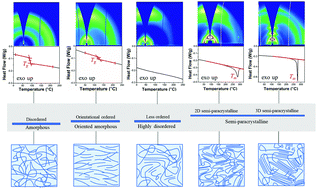Understanding, quantifying, and controlling the molecular ordering of semiconducting polymers: from novices to experts and amorphous to perfect crystals
Abstract
Molecular packing and texture of semiconducting polymers are often critical to the performance of devices using these materials. Although frameworks exist to quantify the ordering, interpretations are often just qualitative, resulting in imprecise use of terminology. Here, we reemphasize the significance of quantifying molecular ordering in terms of degree of crystallinity (volume fractions that are ordered) and quality of ordering and their relation to the size scale of an ordered region. We are motivated in part by our own imprecise and inconsistent use of terminology in the past, as well as the need to have a primer or tutorial reference to teach new group members. We strive to develop and use consistent terminology with regards to crystallinity, semicrystallinity, paracrystallinity, and related characteristics. To account for vastly different quality of ordering along different directions, we classify paracrystals into 2D and 3D paracrystals and use paracrystallite to describe the spatial extent of molecular ordering in 1–10 nm. We show that a deeper understanding of molecular ordering can be achieved by combining grazing-incidence wide-angle X-ray scattering and differential scanning calorimetry, even though not all aspects of these measurements are consistent, and some classification appears to be method dependent. We classify a broad range of representative polymers under common processing conditions into five categories based on the quantitative analysis of the paracrystalline disorder parameter (g) and thermal transitions. A small database is presented for 13 representative conjugated and insulating polymers ranging from amorphous to semi-paracrystalline. Finally, we outline the challenges to rationally design more perfect polymer crystals and propose a new molecular design approach that envisions conceptual molecular grafting that is akin to strained and unstrained hetero-epitaxy in classic (compound) semiconductors thin film growth.

- This article is part of the themed collection: Recent Review Articles


 Please wait while we load your content...
Please wait while we load your content...
